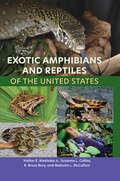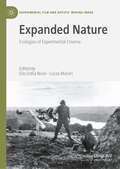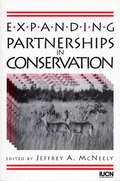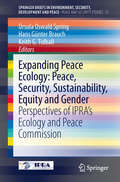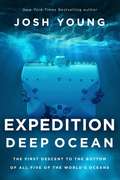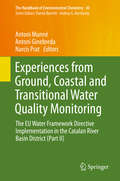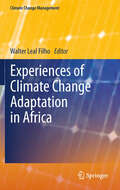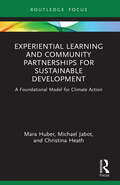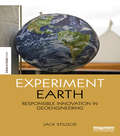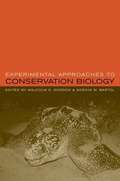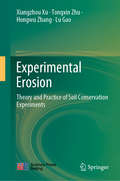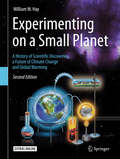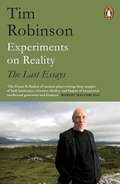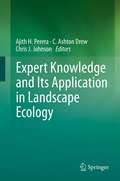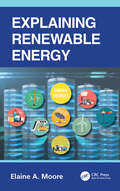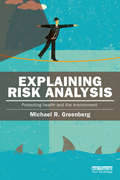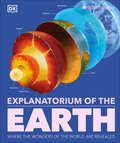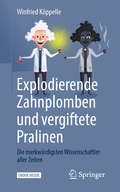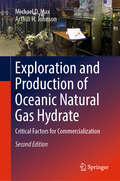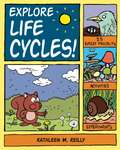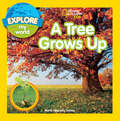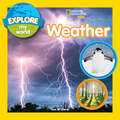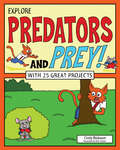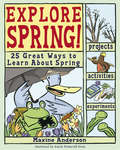- Table View
- List View
Exotic Amphibians and Reptiles of the United States
by Walter E. Meshaka Jr. Suzanne L. Collins R. Bruce Bury Malcolm L. McCallumThe first complete field guide to the exotic amphibians and reptiles established in the continental United States and Hawaiʻi, this volume covers 74 species that are not native to the country and 29 species that are native but occur beyond their original geographic range. Dispersed from their former habitats by human activity, many of these species are invasive in their new environments, causing ecological or economic harm. Ideal for naturalists of all levels, Exotic Amphibians and Reptiles of the United States details each species’ taxonomy, distribution, history, and ecology and portrays each one with vibrant photographs. Drawing on county-level distribution maps from 2,908 published records, this guide provides an in-depth understanding of local factors that drive the success of exotic species. It connects species-specific information to conservation issues as it explores human causes of exotic and invasive establishment. The book also includes eight invited essays which provide regional perspectives on scientific, economic, and management-related aspects of this phenomenon. As ecological pressures on native species and habitats increase, understanding the histories and roles of exotic species is becoming more and more important for conservation efforts. Providing practical identification skills and an awareness of the environmental impacts of these amphibians and reptiles, this indispensable guide equips readers to confront the unusual biodiversity crisis of exotic species.
Expanded Nature: Écologies du cinéma expérimental (Experimental Film and Artists’ Moving Image)
by Elio Della Noce Lucas MurariThis book explores the emergence of ecological consciousness in the work of contemporary experimental filmmakers. If it can be said that experimental filmmakers are "expanding" the artistic field through an exploration of the potencies, modes of dissemination and performance of the moving image, in the Anthropocene these practices strive for another kind of expansion: to expand our experience of nature. Appending flowers to the film strip or burying it in the ground, inventing observational devices, allowing the camera to be affected by natural forces, engaging one's own filming body in a symbiotic relationship with the environment, reconstituting ecosystems at the moment of projection: the ecologies of experimental cinema presented in this book constitute forms of practice and engagement that awaken a heightened sensibility towards the living world through cooperative links, casting other beings as subjects and agents of filmic processes, and, finally, reshaping the economy of filmmaking. Thus, ecologies of perception, medium, production, and multinaturalism are deployed, contributing to the restoration of our sensory bond with the natural world. Several chapters were translated with the help of artificial intelligence. In each case, the text has subsequently been revised further by the author as well as the translator Charlie Hewison and a professional copy editor.
Expanding Partnerships in Conservation: Science, Trends, And The Challenge Of Sustainability
by Jeffrey A. McneelyProtected areas around the globe national parks, wildlife reserves, biosphere reserves will prosper only if they are supported by the public, the private sector, and the full range of government agencies. Yet such support is unlikely unless society appreciates the importance of protected areas to its own interest, and the protected areas are well-managed and contribute to the national welfare in a cost-effective way.A crucial foundation for success is full cooperation between individuals and institutions. Based on papers presented at the IVth World Congress on National Parks and Protected Areas, Expanding Partnerships in Conservation explores how new and stronger partnerships can be formed between managers of protected areas and other sectors of society. It describes a range of activities currently underway in many parts of the world that are intended to improve conservation efforts at the international, national, and local levels.
Expanding Peace Ecology: Peace, Security, Sustainability, Equity and Gender
by Keith G. Tidball Úrsula Oswald Spring Hans Günter BrauchThis book has peer-reviewed chapters by scholars from Australia, Canada, Germany, Japan, Mexico and the USA that were presented to the Ecology and Peace Commission (EPC) of the International Peace Research Association (IPRA) in November 2012 in Japan. The chapters address these themes: Expanding Peace Ecology - Peace, Security, Sustainability, Equity and Gender; Two Discourses on Global Climate Change Impacts: From Climate Change and Security to Sustainability Transition; Peace Research and Greening in the Red Zone: Community-based Ecological Restoration to Enhance Resilience and Transitions Toward Peace; Social and Environmental Vulnerability in a River Basin of Mexico; Mobile Learning, Rebuilding Community Through Building Communities, Supporting Community Capacities: Post Natural Disaster Experience; Transforming Consciousness through Peace Environmental Education; Building Peace by Rebuilding Community; Ability Expectations and Peace and on Satoyama Sustainability and Peace.
Expedition Deep Ocean: The First Descent to the Bottom of All Five Oceans
by Josh YoungThe riveting story of the exploration of the final frontier of our planet—the deep ocean—and history-making mission to reach the bottom of all five seas.Humankind has explored every continent on earth, climbed its tallest mountains, and gone into space. But the largest areas of our planet remain largely a mystery: the deep oceans. At over 36,000 feet deep, there areas closest to earth&’s core have remained nearly impossible to reach—until now. Technological innovations, engineering breakthroughs and the derring-do of a team of explorers, led by explorer Victor Vescovo, brought together an audacious global quest to dive to the deepest points of all five oceans for the first time in history. The expedition pushed technology to the limits, mapped hidden landscapes, discover previously unknown life forms and began to piece together how life in the deep oceans effects our planet—but it was far from easy. Expedition Deep Ocean is the inside story of this exploration of one of the most unforgiving and mysterious places on our planet, including the site of the Titanic wreck and the little-understood Hadal Zone. Vescovo and his team would design the most advanced deep-diving submersible ever built, where the pressure on the sub is 8 tons per square inch—the equivalent of having 292 fueled and fully loaded 747s stacked on top of it. And then there were hurricane-laden ocean waters and the byzantine web of global oceanography politics. Expedition Deep Ocean reveals the marvelous and other-worldly life found in all five deep ocean trenches, including several new species that have posed as of yet unanswered questions about survival and migration from ocean to ocean. Then there are the newly discovered sea mounts that cause tsunamis when they are broken by shifting subduction plates and jammed back into the earth crust, something that can now be studied to predict future disasters. Filled with high drama, adventure and the thrill of discovery, Expedition Deep Ocean celebrates courage and ingenuity and reveals the majesty and meaning of the deep ocean.
Experiences from Ground, Coastal and Transitional Water Quality Monitoring
by Antoni Ginebreda Antoni Munné Narcís PratThis book details theexperiences gained by the Catalan Water Agency (ACA) in a Mediterraneanwatershed - the Catalan River Basin District - following the launch of the EUWater Framework Directive (WFD) in the year 2000. Groundwater and coastal waterexperts present 13 chapters defining tools for water-status assessmentspecially adapted to Mediterranean conditions. The content of this and thecompanion volume Experiences from SurfaceWater Quality Monitoring: The EU Water Framework Directive Implementation inthe Catalan River Basin District (Part I) are the result of an excellentcollaboration between the ACA and several Catalan universities and researchcenters to cope with new challenges provided by the WFD monitoring requirements. The volume serves as a useful guide for environmental managers and scientistsengaged in other European as well as Non-European river basins.
Experiences of Climate Change Adaptation in Africa
by Walter Leal FilhoIt is widely acknowledged that, in addition to global and regional efforts to cope with climate change by means of mitigation measures, adaptation initiatives can and perhaps should play a key role in enabling communities from across Africa to better handle the problems related to it. Due to the fact that experiences in climate change adaptation in Africa are poorly documented, this book provides an attempt to address the perceived need for better documentation and dissemination of African experiences on climate change adaptation.
Experiential Learning and Community Partnerships for Sustainable Development: A Foundational Model for Climate Action (Routledge Research in Higher Education)
by Mara Huber Michael Jabot Christina HeathThis book addresses the growing demand for applied experiences that move students beyond learning into the realm of doing by supporting the development of skills and competencies that align with emerging areas of innovation and work. It considers the urgent need to promote and invest in skills that support sustainable development, such as those needed to analyze and mitigate climate change. The authors argue that this challenge provides an opportunity to reimagine the use of Experiential Learning, connecting students with community-based partners doing the work of sustainable development around the world. Featuring compelling case studies of project partners in Nigeria, Uganda, and Tanzania working to address the complexities of climate change, they offer a practical model for implementing Experiential Learning that can be translated and scaled across sectors and resource environments. It is aimed at scholars and educators working across higher education and international education with interests in digital and experiential education.
Experiment Earth: Responsible innovation in geoengineering (The Earthscan Science in Society Series)
by Jack StilgoeExperiments in geoengineering – intentionally manipulating the Earth’s climate to reduce global warming – have become the focus of a vital debate about responsible science and innovation. Drawing on three years of sociological research working with scientists on one of the world’s first major geoengineering projects, this book examines the politics of experimentation. Geoengineering provides a test case for rethinking the responsibilities of scientists and asking how science can take better care of the futures that it helps bring about. This book gives students, researchers and the general reader interested in the place of science in contemporary society a compelling framework for future thinking and discussion.
Experimental Approaches to Conservation Biology
by Malcolm S. Gordon Soraya M. BartolEnvironmental and biological researchers from around the world present a selection of current case studies relevant to protecting world biodiversity that illustrate issues in both basic and applied experimental biology, at a level accessible to students and non scientists as well as active researcher. The also want to raise the visibility of organism-centered experimentation as a valid and useful approach to conservation biology, and to narrow the gap that divides researchers from managers and policymakers charged with protecting biodiversity. The 18 selected papers were to be presented a September 2001 conference in Los Angeles, but some were not delivered because air traffic was closed and authors could not reach Los Angeles. Annotation ©2004 Book News, Inc., Portland, OR (booknews.com)
Experimental Erosion: Theory and Practice of Soil Conservation Experiments
by Xiangzhou Xu Tongxin Zhu Hongwu Zhang Lu GaoThis book is the first to systematically explore experimental erosion by integrating theory, erosion observations, and conservation applications. Although numerous books have been published on soil erosion both in English and in Chinese, none has concentrated on experimental studies on the Loess Plateau of China, in an attempt to establish a new sub-discipline: experimental erosion. One main objective of this book is to highlight monitoring and modeling methods for soil scientists who design and conduct experimental studies on soil loss. Another objective, and the most important one, is to make the results of these experiments more generally available. Accordingly, we have gathered and integrated a broad range of experimental results, both published and unpublished. In-depth discussions of the experimental data and new data processing methods are also included. The work covered here represents exemplary studies in the field of soil erosion and conservation, while the new methods and findings presented will provide practical guidance for controlling soil erosion. Hence the book offers a valuable resource for graduate students, soil erosion scientists and engineers, and soil and water conservationists.
Experimenting on a Small Planet
by William W. HayThis book is a thorough introduction to climate science and global change. The author is a geologist who has spent much of his life investigating the climate of Earth from a time when it was warm and dinosaurs roamed the land, to today's changing climate. Bill Hay takes you on a journey to understand how the climate system works. He explores how humans are unintentionally conducting a grand uncontrolled experiment which is leading to unanticipated changes. We follow the twisting path of seemingly unrelated discoveries in physics, chemistry, biology, geology, and even mathematics to learn how they led to our present knowledge of how our planet works. He explains why the weather is becoming increasingly chaotic as our planet warms at a rate far faster than at any time in its geologic past. He speculates on possible future outcomes, and suggests that nature itself may make some unexpected course corrections. Although the book is written for the layman with little knowledge of science or mathematics, it includes information from many diverse fields to provide even those actively working in the field of climatology with a broader view of this developing drama. Experimenting on a Small Planet is a must read for anyone having more than a casual interest in global warming and climate change - one of the most important and challenging issues of our time.
Experiments on Reality
by Tim RobinsonLong recognized as perhaps the greatest non-fiction writer at work in Ireland, for his vast, polymathic accounts of nature and culture in the Aran Islands and Connemara, Tim Robinson is also an essayist of genius whose fascinations range across the globe. In Experiments on Reality, he shines the light of his intelligence on his own life, and on some of the most fascinating questions in science and culture. Robinson brings us to his boyhood in Yorkshire, National Service in Malaya in the 1950s, and his years as a visual artist in Istanbul, Vienna and London. He revisits some of the scenes of his researches for the maps he made of Aran and Connemara, places that continue to throw up remarkable stories and puzzles. And he performs astonishing literary thought-experiments, playing with the boundaries of the essay form, scientific inquiry, and storytelling. Experiments on Reality is a masterpiece from one of the great minds of our time.'One of the greatest of all landscape writers ... When the material world is brought forth for us so beautifully, with such rapt attention and illuminating insight, we are reminded of how lucky we are to be part of it' Fintan O'Toole, Irish TimesPRAISE FOR THE CONNEMARA TRILOGY:'One of the most remarkable non-fiction projects undertaken in English' Robert MacFarlane, Spectator'Robinson is a marvel ... the supreme practitioner of geo-graphy, the writing of places' Fintan O'Toole, Observer Books of the Year'One of contemporary Ireland's finest literary stylists ... This is a book that does justice, in every sense of that phrase, to the frequently betrayed people whose stories it incarnates, and to their strange and beautiful corner of the world' Joseph O'Connor, Guardian'A masterpiece of travel and topographical writing and a miraculous, vivid and engrossing meditation on landscape and history and the sacred mood of places' Colm Tóibín, Irish Times Books of the Year'One of the finest of contemporary prose stylists' John Burnside, Irish Times'He is that rarest of phenomena, a scientist and an artist, and his method is to combine scientific rigour with artistic reverie in a seamless blend that both informs and delights.' John Banville, Guardian'Breathtaking ... the West of Ireland has found its ultimate laureate' Patricia Craig, TLS'Dazzling ... an indubitable classic' Giles Foden, Condé Nast Traveller
Experiments with Plants: A True Book
by Salvatore TocciNine easy-to-follow experiments help readers explore what a plant is, what it needs to grow and live, what's inside a plant seed, and how seeds grow and get spread in the wild.
Expert Knowledge and Its Application in Landscape Ecology
by C. Ashton Drew Chris J. Johnson Ajith H. PereraTypically, landscape ecologists use empirical observations to conduct research and devise solutions for applied problems in conservation and management. In some instances, they rely on advice and input of experienced professionals in both developing and applying knowledge. Given the wealth of expert knowledge and the risks of its informal and implicit applications in landscape ecology, it is necessary to formally recognize and characterize expert knowledge and bring rigor to methods for its applications. In this context, the broad goal of this book is to introduce the concept of expert knowledge and examine its role in landscape ecological applications. We plan to do so in three steps: First we introduce the topic to landscape ecologists, explore salient characteristics of experts and expert knowledge, and describe methods used in capturing and formalizing that knowledge. Second, we present examples of research in landscape ecology from a variety of ecosystems and geographic locations that formally incorporate expert knowledge. These case studies address a range of topics that will interest landscape ecologists and other resource management and conservation professionals including the specific roles of expert knowledge in developing, testing, parameterizing, and applying models; estimating the uncertainty in expert knowledge; developing methods of formalizing and incorporating expert knowledge; and using expert knowledge as competing models and a source of alternate hypotheses. Third, we synthesize the state of knowledge on this topic and critically examine the advantages and disadvantages of incorporating expert knowledge in landscape ecological applications. The disciplinary subject areas we address are broad and cover much of the scope of contemporary landscape ecology, including broad-scale forest management and conservation, quantifying forest disturbances and succession, conservation of habitats for a range of avian and mammal species, vulnerability and conservation of marine ecosystems, and the spread and impacts of invasive plants. This text incorporates the collective experience and knowledge of over 35 researchers in landscape ecology representing a diverse range of disciplinary subject areas and geographic locations. Through this text, we will catalyze further thought and investigations on expert knowledge among the target readership of researchers, practitioners, and graduate students in landscape ecology.
Explaining Renewable Energy
by Elaine A. MooreThis undergraduate text aimed primarily at high schoolers and lower level undergraduates focuses on explaining how the various forms of renewable energy work and the current ongoing research. It includes sections on non-scientific aspects that should be considered such as availability of resources. A final chapter covers methods of removing carbon dioxide from the atmosphere.Renewable energy is currently on everyone’s mind in the context of climate change. This text provides students with an introduction into the science behind the various types of renewable energy enabling them to access review literature in the field and options that that should be considered when selecting methods. Features Collates the most relevant and up to date information on renewable energy systems in a user friendly format for undergraduate and high school students. Focuses on power production technologies from renewable energy sources. An introduction to how sources of renewable energy work; their advantages and drawbacks. Timely text with the need for fast adoption of renewable energy technologies around the world. Suitable for a diverse audience including students with some scientific background such as final year in high school wanting to know more about combatting climate change.
Explaining Risk Analysis: Protecting health and the environment (Earthscan Risk in Society)
by Michael R GreenbergRisk analysis is not a narrowly defined set of applications. Rather, it is widely used to assess and manage a plethora of hazards that threaten dire implications. However, too few people actually understand what risk analysis can help us accomplish and, even among experts, knowledge is often limited to one or two applications. Explaining Risk Analysis frames risk analysis as a holistic planning process aimed at making better risk-informed decisions and emphasizing the connections between the parts. This framework requires an understanding of basic terms, including explanations of why there is no universal agreement about what risk means, much less risk assessment, risk management and risk analysis. Drawing on a wide range of case studies, the book illustrates the ways in which risk analysis can help lead to better decisions in a variety of scenarios, including the destruction of chemical weapons, management of nuclear waste and the response to passenger rail threats. The book demonstrates how the risk analysis process and the data, models and processes used in risk analysis will clarify, rather than obfuscate, decision-makers’ options. This book will be of great interest to students and scholars of risk assessment, risk management, public health, environmental science, environmental economics and environmental psychology.
Explanatorium of the Earth (DK Explanatorium)
by DKWelcome to the Explanatorium of the Earth - the only Earth encyclopedia for children you'll ever need, with amazing photographs of everything from supervolcanoes to tsunamis.What makes volcanoes erupt? Why are tornadoes and hurricanes so destructive? How do rocks, fossils, and gems form? Explanatorium of the Earth takes you on an incredible voyage deep into the heart of our planet and back to discover the powerful forces that continually shape and remodel our ever-changing world. Discover how tectonic plates tear apart and collide, moving inch by inch to create continents, mountain ranges, oceans, and volcanoes. Witness the destructive power of earthquakes, tsunamis, and hurricanes. Learn how the slow but relentless process of erosion and weathering wear away rock, reducing mountains to dust and carving valleys and canyons into the land. And learn how the living world and rock cycles have worked together for millions of years to stabilize the planet's climate, keeping Earth suitable for life.
Explodierende Zahnplomben und vergiftete Pralinen: Die merkwürdigsten Wissenschaftler aller Zeiten
by Winfried KöppelleEin schottischer Genetiker begeistert sich für Sauerstoffentzug und Stickstoffvergiftungen, pustet sich Zigarrenrauch durchs perforierte Trommelfell und steckt die eigene Gattin in seine Unterdruckkammer.Eine inselbegabte Autistin kriecht auf allen Vieren durch Schlachthöfe, entspannt sich in ihrer selbsterfundenen „Presskiste“, und steigt zur führenden Expertin für humanes Metzgerhandwerk auf.Ein Selfmade-Chemiker rottet mit seinen Erfindungen beinahe die Menschheit aus – und erwürgt sich mit einer seiner Konstruktionen versehentlich selbst.Ein Anthropologie-Professor fabriziert an der Uni illegale Drogen und wandert hinter Gitter. Nach seiner Entlassung schickt er seinem Richter vergiftete Pralinen – und bekommt lebenslänglich.Wer schon immer vermutete, dass intelligente Menschen oft auch sehr eigenartige Zeitgenossen sind – hier der Beweis: Zehn Kurzbiografien zwischen Genie und Wahnsinn – zehnmal Unerhörtes, Sagenhaftes, Haarsträubendes und Skandalöses aus der elitären Welt der Spitzenforschung.
Exploration and Production of Oceanic Natural Gas Hydrate: Critical Factors For Commercialization
by Michael D. Max Arthur H. JohnsonThis second edition provides extensive information on the attributes of the Natural Gas Hydrate (NGH) system, highlighting opportunities for the innovative use and modification of existing technologies, as well as new approaches and technologies that have the potential to dramatically lower the cost of NGH exploration and production.Above all, the book compares the physical, environmental, and commercial aspects of the NGH system with those of other gas resources. It subsequently argues and demonstrates that natural gas can provide the least expensive energy during the transition to, and possibly within, a renewable energy future, and that NGH poses the lowest environmental risk of all gas resources.Intended as a non-mathematical, descriptive text that should be understandable to non-specialists as well as to engineers concerned with the physical characteristics of NGH reservoirs and their production, the book is written for readers at the university graduate level. It offers a valuable reference guide for environmentalists and the energy community, and includes discussions that will be of great interest to energy industry professionals, legislators, administrators, regulators, and all those concerned with energy options and their respective advantages and disadvantages.
Explore Life Cycles!
by Kathleen M. Reilly Bryan StoneExplore Life Cycles! takes kids on an amazing journey, where they'll learn about the changes plants and animals experience throughout their lives. Kids ages 6-9 will discover what happens inside those magical cocoons to transform a caterpillar into a butterfly. They'll explore how frogs breathe underwater as tadpoles, then use lungs as an adult. Explore Life Cycles! will examine how plants and animals are born, develop, and live their lives.Activities range from creating edible life cycles of insects to making a mealworm nursery. Using an eye-catching combination of cartoons, fun facts, and exciting projects, Explore Life Cycles! will bring the mysteries of life right into kids' hands.
Explore My World A Tree Grows Up (Explore My World)
by Marfe Ferguson DelanoIn this charming picture book, curious little kids will learn all about how an acorn grows up to be an oak tree. The story includes the stages of growth of a tree throughout the seasons and year. It also introduces the happenings around the tree, from children playing in its shade to squirrels climbing up its trunk and birds nesting in its branches. These engaging Explore My World picture books on subjects kids care about combine simple stories with unforgettable photography. They invite little kids to take their first big steps toward understanding the world around them and are just the thing for parents and kids to curl up with and read aloud.
Explore My World: Weather (Explore My World)
by Lisa M. GerryPacked with colorful photographs of adorable animals braving the elements, this picture book for preschoolers introduces kids to the weather they experience every day, including rain, clouds, sunshine, snow, storms, and more.From snowflakes to raindrops to puddles, from sunny days to cloudy days to blustery days, young readers will be amazed by the wondrous and ever-changing world of weather. These engaging Explore My World picture books, on subjects kids care about, combine simple storytelling with unforgettable photography. They invite little kids to take their first big steps toward understanding the world around them and are just the thing for parents and kids to curl up with and read aloud.
Explore Predators and Prey!: With 25 Great Projects
by Cindy Blobaum Matt AucoinHunting, hiding, trapping, and tricking are just a few of the strategies used by animals in the wild to ensure they eat enough without being eaten themselves! In Explore Predators and Prey! With 25 Great Projects, readers ages 7 through 10 explore the physical and behavioral adaptations of predators and prey and their impact on the environment.Predators, such as hawks and foxes, have keen eyesight and sharp beaks and teeth to help them catch their prey. Prey, such as mice and rabbits, have large ears to hear danger and can move quickly to escape their enemies. Animal populations are closely integrated with each other and the surrounding environment. A change to one population causes changes to all others. Readers discover how repercussions can affect nature, including humans, and are encouraged to consider their own actions with an eye toward the effect on the environment.In Explore Predators and Prey, kids actively learn about body tools and behavior strategies as they test their own abilities to hunt and hide in a series of science-minded activities. Fun facts and colorful cartoons make learning entertaining and links to online primary sources and videos make the content accessible to all learners.
Explore Spring!
by Lauri Berkenkamp Alexis Frederick-FrostFrom tracking spring peepers and raising tadpoles to learning about seeds and recording plant growth, Explore Spring! 25 Great Ways to Learn About Spring invites young readers to explore the wonders of spring by becoming scientists in the field. Combining hands-on learning with solid science, trivia, riddles, and terrific illustrations, projects investigate "the reason for the season" and include identifying trees and measuring their growth, recording soil temperature, and observing the forest floor. Bird migration and nest building are covered, and the movement of air and water is studied with experiments in capillary action and in such activities as "Making Parachutes," Making Kites," and "Mapping Air Currents with Bubbles."
